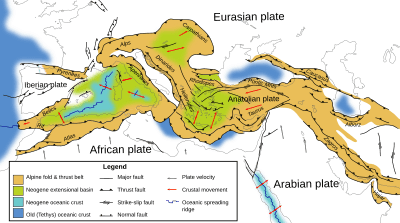Alpine orogeny facts for kids
The Alpine orogeny (say: or-OH-jen-ee) is the name for the amazing process that built many of the huge mountain ranges in central and southern Europe and western Asia. Think of it like a giant, slow-motion collision!
This mountain-building started a very long time ago, in the later Mesozoic era. It happened because two massive continents, Africa and India, along with some smaller land plates, slowly moved north. They crashed into the continent of Eurasia. This slow collision began near the end of the Mesozoic era and is actually still happening today, though very, very slowly!
Contents
How Mountains Formed
When these continents collided, they squeezed the Earth's crust in the Eurasian plate. This squeezing caused the land to buckle, fold, and push upwards, creating enormous mountain ranges. These mountains stretch from the western edge of Europe all the way into Asia.
The Alpide Mountain Belt
The long chain of mountains created by the Alpine orogeny is called the Alpide belt. This belt includes many famous mountain ranges you might know. From west to east, they are:
- The Atlas Mountains in North Africa
- The Rif mountains
- The Baetic Cordillera and Cantabrian Mountains in Spain
- The Pyrenees between Spain and France
- The Alps in central Europe
- The Apennine Mountains in Italy
- The Dinaric Alps
- The Hellenides
- The Carpathian Mountains
- The Balkan Mountains
- The Taurus Mountains
- The Armenian Highlands
- The Caucasus Mountains
- The Alborz
- The Zagros Mountains
- The Hindu Kush
- The Pamir Mountains
- The Karakoram
- And the mighty Himalayas!
Distant Effects of the Alpine Orogeny
The Alpine orogeny was so powerful that it even affected areas far away from the main collision zone. For example, it helped create the chalk hills in southern England and northern France. You can still see the results of this in the chalk ridges of the North Downs and South Downs in southern England.
Its effects are also clear on the Isle of Wight. Here, the chalk and other rock layers are folded almost vertically, like a giant book standing on its spine. You can see this amazing sight at places like Alum Bay and Whitecliff Bay, and along the Dorset coast near Lulworth Cove.
Other Mountain-Building Events
The Alpine orogeny was the most recent of three major mountain-building phases that shaped the geology of Europe.
- The first was the Caledonian orogeny. This event formed the ancient continent known as the Old Red Sandstone continent.
- The second was the Variscan orogeny. This happened when the supercontinent Pangaea formed, as Gondwana collided with the Old Red Sandstone continent during the middle to late Paleozoic era.
See also
 In Spanish: Orogenia alpina para niños
In Spanish: Orogenia alpina para niños


